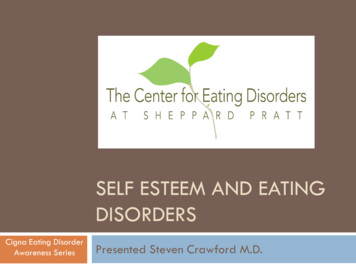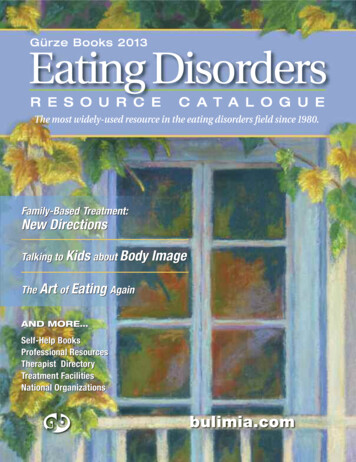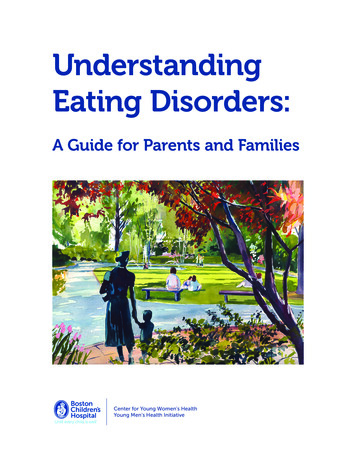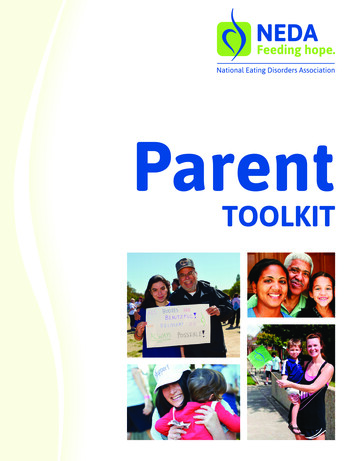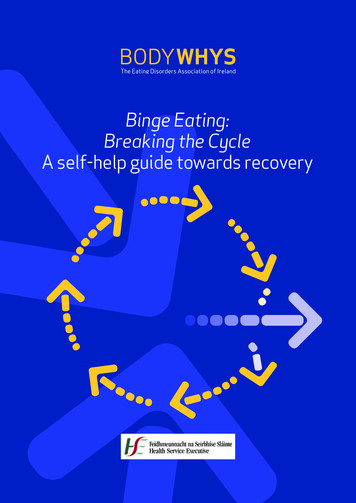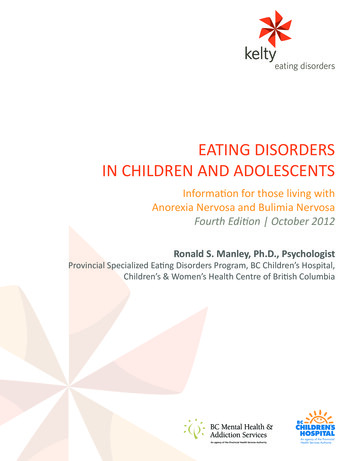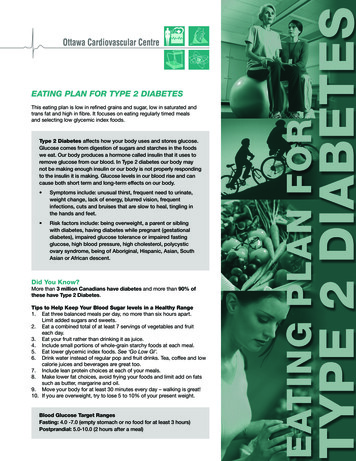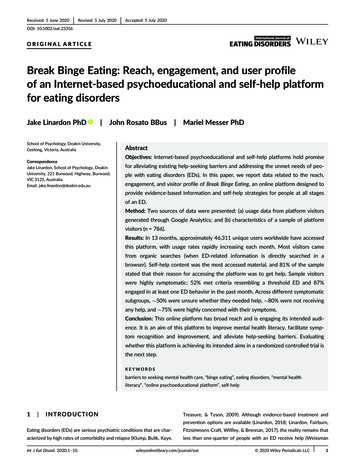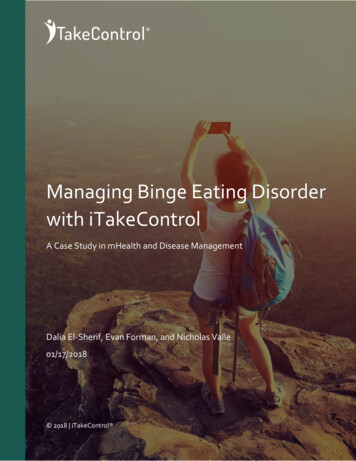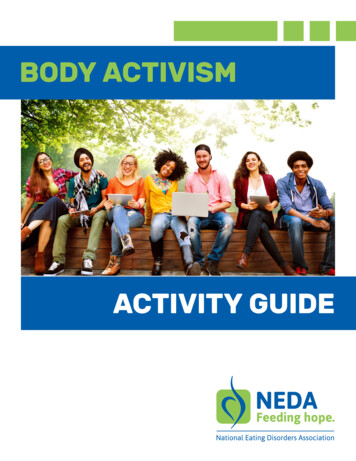
Transcription
BODY ACTIVISMACTIVITY GUIDE
TABLE OF CONTENTSIntroductionWhy a Guide for Body Activism? . 3About the Body Project. 3Suggestions on How to Use the Guide . 4Let Us Know How It Goes! . 4Join the Conversation on Social Media . 4Recommendations for Self-Care. 5What to Do If You Feel Triggered . 5ActivitiesBody Acceptance Baseline (T/F) . 6Activity #1: Social MEdia Break Down. 7Activity #2: Let’s Make ADifference . 9Activity #3: Letter for Change . 11Activity #4: The Name Game . 13Activity #5: Give a Compliment. 15Activity #6: Self (Esteem) Portrait . 17Sample Figure Outlines. 19Activity #7: Reshaping Body Image . 25Activity #8: Change the Beat. 28Activity #9: Dear Body, . 30Activity#10: Love Your Selfie . 32Body Acceptance Follow Up (T/F) . 34ResourcesInformation & Support . 35Glossary . 36Inspirational Quotes . 38Questions? Visit www.myNEDA.org for eating disorders information, resources, and treatment options.2
Have you ever wondered why you don’t look like the people on TV or in magazines?Are you looking to improve your body image and self-esteem? The National EatingDisorders Association (NEDA) is excited to present this fun and empowering activityguide, which encourages you to critique media images, take a stand againstunrealistic beauty standards, and challenge your personal body-related concerns.Why a Guide for Body Activism?In the United States, 30 million people will struggle with an eating disorder at somepoint in their lives. Early intervention efforts aimed to increase body acceptance canreduce disordered eating symptoms as well as help to create an environment thatencourages healthy recovery. Numerous studies have linked exposure to prevalent“appearance ideal” in mass media to body dissatisfaction and disordered eating. Likewise,low self-esteem is a common characteristic of individuals who have eating disorders. Bodyacceptance reinforces the value that “true beauty” is not simply skin deep and, here atNEDA, we recognize the importance of body acceptance, media literacy, and more. We arestarting a movement! Change begins at home, in our personal conversation with friendsand family, and even with how we talk to ourselves!About The Body ProjectIn an effort to promote body acceptance and prevent eating disorder onset, NEDAdisseminates the Body Project; a body confidence and self-esteem program for highschool and college-aged girls. Backed by more than two decades of research andevaluation data, the program gives girls the tools and skills to confront unrealistic beautyideals and engages them in the development of a healthy body image. This interventionhas been delivered to over one million young women around the world and has repeatedlybeen shown to effectively reduce body dissatisfaction, negative mood, unhealthy dietingand disordered eating.The Body Project engages participants to consider the costs of conforming to rigid societalappearance ideals through role-plays, written exercises, media literacy, and body activism.In the spirit of expanding the impact of the Body Project, we created a guide with activitiesto spark discussion about body diversity and encourage participants to speak up and speakout against unrealistic appearance norms. The activities in this guide are inspired byvarious body activism carried out by our teenage Body Project participants. While the BodyProject intervention is targeted to young women and girls, these activities are intended forall ages and genders.Questions? Visit www.myNEDA.org for eating disorders information, resources, and treatment options.3
Suggestions on How to Use the Guide In the classroom – Choose activities to complete individually or as a group. Afterstudents complete each activity, the teacher or class leader can facilitate adiscussion pulling from the questions to think about. With friends – Relaxing night in? Grab some snacks, your friends, and give theseactivities a go. Feel free to work together to come up with ideas, discuss yourfindings, and become stellar body activists. At family night – Research shows that 81% of 10 year olds are afraid of being fat.Older relatives (e.g., parents, siblings, or cousins) are in the unique position to bringawareness to negative feelings about their loved one’s body. Using this activityguide, you can have an open dialogue about societal pressures and help cultivatebody acceptance with your family members.Let Us Know How It Goes!We hope you find these activities fun and engaging, and that they inspire you to continueyour activism. Please email info@myneda.org with any photos of your activism projects.Select photos and letters may be reposted on our social media pages.The National Eating Disorders Association (NEDA) is active on a variety of social mediaplatforms. Let’s get social, strengthen our recovery community, stay up to date on thelatest news, and create a world without eating disorders – together!Join the Conversation on Social Media Like us on Facebook for inspirational posts, news from the field, and support via Messenger.Follow us on Instagram for daily doses of encouragement and pro-recovery images!Follow us on Twitter for the latest news on eating disorders, recovery support, andways to get involved.Read our Tumblr blog for recovery tips and information.Check out our Pinterest boards for visual inspiration, fundraising tips, and NEDAWalks team spirit ideas!Questions? Visit www.myNEDA.org for eating disorders information, resources, and treatment options.4
Recommendations for Self-CareIf you are in recovery or struggling with body image and eating concerns, it is important tobe mindful of how you feel as you complete these exercises. It is imperative to stayfocused on your own recovery before challenging societal beauty and body ideals.BEFORE BECOMING A BODY IMAGE ADVOCATE, BE SURE YOU’RE ANADVOCATE FOR YOURSELF!What to Do If You Feel TriggeredPlease note that some the topics and exercises in this guide may bring up a lot ofemotions, and we encourage you to check-in with yourself after each activity. If you findthat certain exercises are particularly difficult or uncomfortable for you, considerjournaling, meditating, and/or discussing your experience with a therapist. If you do nothave a therapist and would like to connect with one, you can visit NEDA’s directory offacilities and treatment providers or connect with NEDA’s toll free, confidential Helplinethrough phone, chat, or Facebook messenger. You can also refer to the resource page atthe end of the manual for additional organizations and resources.Questions? Visit www.myNEDA.org for eating disorders information, resources, and treatment options.5
BODY ACCEPTANCE BASELINE (T/F)Read the following questions to help measure how accepting you are with your body and ofyourself. Write true (T) if you agree with the statement and false (F) if the statementdoesn’t currently ring true for you. If you found yourself answering false for many of thesestatements, you may find these activities especially helpful in challenging the ways inwhich you’ve internalized the pressure to conform to the appearance-ideal. At the end ofthis guide, you will see this checklist again on page 34 and we hope you have noticed animprovement in the way you perceive your body.I like the way I look and appreciate my unique traitsI can easily name my favorite body partI look in the mirror and see a beautiful person looking backI do not participate in group body bashing of myself and othersI move my body in ways that are joyful and fun without the goal ofchanging my physical appearanceI do not compare my appearance to anyone elseI compliment others for their accomplishments rather than theirappearanceI wear clothing that fits my body and makes me feel good regardlessof the sizeI do not comment on other people’s weightI do not let the number on the scale determine my self-worthI do not avoid certain activities or clothing for fear of judgementI post realistic, unedited photos of myself on social mediaI know that media does not set the standards of beauty or perfectionI don’t feel the need to alter my natural physical appearanceI realize that I’m beautiful no matter what shape or size I amI know that true beauty is not simply skin deepQuestions? Visit www.myNEDA.org for eating disorders information, resources, and treatment options.6
Activity #1: Social MEdia Break DownWe often compare ourselves to others both inour day-to-day life and on social media.Research indicates that social media use cancontribute to body dissatisfaction anddisordered eating; however, it can also be usedto promote media literacy, self-acceptance,and body image activism. In this activity, wewill examine how our social media activity mayunintentionally perpetuate the appearanceideal.Materials Phone, computer, or tabletPen (for “General Questions” checklist)Instructions1. Grab a nearby phone, get on your computer, or pull out that tablet that you carryeverywhere.2. Take a look at your social media apps or websites: Instagram, Facebook, Snapchat,Twitter, Tumblr, YouTube, etc.3. Review your photos, posts, comments, and likes.4. Complete the checklist below, which is designed to increase awareness of socialmedia behaviors perpetuating the appearance-ideal in our culture. Circle “yes” forthe behaviors you have engaged in while using social media.General Questions Does social media has a negative effect on your body image? Is social media a competition to earn the most followers, likes, and comments? Do you compare your life to others based on their social media posts?yesyesyesPictures Do you pose in pictures so your body contorts to the appearance-ideal? Do you edit your pictures before uploading to enhance your appearance? Have you untagged yourself from a picture you didn’t like of yourself?Questions? Visit www.myNEDA.org for eating disorders information, resources, and treatment options.yesyesyes7
Written Posts Do you post about going to the gym, what you eat, or your appearance? Do you spend a lot of time refining a post that is meant to appear casual? Do you delete posts if they do not receive enough comments or likes?yesyesyesComments Do you make appearance-related comments on your friends’ photos? Have you refrained from liking a friend’s photo because it wasn’t flattering? Have you posted a comment about someone’s body or appearance, even thoughit wasn’t the focus of the photo?yesyesyesLikes and Follows Does getting “likes” give you a boost of confidence or higher self-esteem? Do you compare your body/appearance to your other followers? Do you habitually check your notifications after posting a picture, tweet, or status?yesyesyesQuestions to Think About How might social media have a negative impact on one’s body image/ self-esteem?How can social media be used as a tool to inspire (body) positivity?What are some strategies you can use to eliminate harmful social media behaviors?Did You Know? 21% of teens feel worse about themselves after using social media (Pew ResearchCenter, 2015). 70% of women and 50% of men aged 18 to 35 edit their images before posting themon social media (Renfrew Center Foundation, 2014). NEDA has joined forces with Facebook and Instagram in the fight against eatingdisorders. Their innovative tools and commitment to the cause have helped usreach millions with the support and resources they deserve.Relevant Resources What Does the Research Tell Us About Social Media and Body Image?6 Questions to Ask Yourself Before Sharing a Social Media PostYou Don’t Have to Be What You See on Social MediaQuestions? Visit www.myNEDA.org for eating disorders information, resources, and treatment options.8
Activity #2: Let’s Make ADifferenceMany media messages and advertisementspresent the false and harmful notion thatpeople will be happy and successful if theyachieve a specific body “ideal.” It is importantto think critically about the images you see onall types of media so you can recognizepotential use of filters and photo retouching.In this activity, we will analyze and evaluatemedia messages that promote a narrow – andoften unattainable – depiction of beauty and success, and recognize the importance ofquestioning media messages.Materials Media images from magazines, the Internet, TV, or moviesPen and paperComputer (optional)Instructions1. Pick up your favorite magazine; search a news website, online shopping mediums,or search “advertisements.”2. Select two advertisements to analyze.3. Write down what catches your eye, focusing on physical characteristics andappearance-related themes.4. Answer the questions below for each advertisement: What caught your eye about this picture?What product or service is being advertised?How is the ad trying to persuade you to take part in or buy their product?Who is the audience for this advertisement? (e.g., age, socioeconomic status, ethnicity,and gender).How does this advertisement appeal to the target audience?Describe the models in the ad. Is there a representation of various genders, ethnicities,abilities, body shapes, and sizes?Did the people in this ad reflect your ideas about what is attractive? If not, what wereyou looking for that you could not find?Does the ad make you feel like you need to fix, change, or buy something to have the“right” look? Why or why not?Questions? Visit www.myNEDA.org for eating disorders information, resources, and treatment options.9
Questions to Think About What messages do the media suggest about people and their physical appearance?How do binary appearance-ideals (i.e., male/female) exclude non-binary folks?Who benefits from these kinds of images? Who do these images hurt?Why is it important to be a critical viewer of media messages?Did You Know? The function of a fashion magazine is to convince people that something is wrongwith them (e.g., hair, body, etc.) so that they can sell their product (i.e., the contentof the magazine) to fix it. Once a photoshoot is complete, images are altered: complexion is cleaned up, eyelines are softened, chins, thighs and stomachs are trimmed, and necklines areremoved. Of American elementary school girls who read magazines, 69% say that the picturesinfluence their concept of the ideal body shape. 47% say the pictures make themwant to lose weight. (Martin, 2010).Relevant Resources Tips for Becoming a Critical Viewer of the MediaMedia, Body Image, and Eating DisordersMedia and Your Body Image: What You Need to KnowQuestions? Visit www.myNEDA.org for eating disorders information, resources, and treatment options.10
Activity #3: Letter for ChangeThe media is a powerful tool that has thepotential to positively or negatively influenceone’s body image. As body activists, it is ourresponsibility to educate industry leaders aboutthe impacts of harmful media messages. In thisactivity, we will advocate againstadvertisements that send negative body imagemessages by writing a letter to an organization,company, or magazine that promotes theappearance-ideal in order to inspire change.Materials Media images from magazines, the Internet, TV, movies, or musicPen and paperComputer (optional)Envelope and stampsInstructions1. Choose an advertisement you examined in the last activity or select another optionfrom print, broadcast, or an online media outlet.2. Grab some paper and a pen (or your computer) and write a letter explaining: What product or service you are concerned about?How the appearance-ideal is being promoted in this advertisement.Why this is a concern and how this ad makes you feel.Suggestions for how to more effectively promote their brand, company, or servicewithout perpetuating unrealistic appearance-ideals3. Research contact information, including names, titles, and company’s mailing oremail address.4. Mail or email your letter and send a copy to info@myneda.org!Optional: Write a letter to a magazine or company you believe is sending positive andinspiring messages, and thank them for celebrating the natural diversity of human bodyshapes, looks, and sizes.Questions? Visit www.myNEDA.org for eating disorders information, resources, and treatment options.11
Questions to Think About How do you think participating in body activism can help you in your pursuit of bodypositivity?What are some companies that promote body diversity, and what are some keypoints of their successful campaigns?After completing this activity, how likely are you to boycott a product or servicethat promotes the appearance-ideal?Did You Know? Most fashion models are thinner than 98% of American women (Smolak, 1996), andonly 5% of women have the body type (tall, genetically thin, broad-shouldered,narrow-hipped, long-legged and usually small-breasted) seen in almost alladvertising. 56% of women said seeing body diversity in media made them feel better aboutthemselves (Refinery29, 2016). Most males would like to be lean and muscular, which typically represents the idealmale body type seen in mass media. Research shows that the sexual objectificationof men and internalization of media images predicts drive for muscularity (Daniel,2010).Relevant Resources Media Watchdog ForumGet REAL! Digital Media Literacy ToolkitClothing Has No Gender: Removing Gender Labels on Kids’ Clothes Can ReducePressure to ConformQuestions? Visit www.myNEDA.org for eating disorders information, resources, and treatment options.12
Activity #4: The Name GameHow often do you look in the mirror andgive yourself a compliment or pat on theback? Many people are more likely to saysomething nice to others than to ourselves,even though we deserve compliments too!In this activity, we will recognize ourpositive qualities and create a poem withthose words to showcase our unique traits.Materials Pen and paperComputer (optional)Dictionary or thesaurus (optional)Instructions1. Decide if you want to use your first name, last name, or nickname.2. Write or type your name vertically, with each letter on a separate line.3. Brainstorm positive affirmations about yourself including accomplishments,personality, values, and appearance. You can use single words, phrases, or even fullsentences in your poem.4. Place your qualities or phrases on the lines that begin with (or contain) the sameletter.5. Make each letter of your name a positive affirmation.Optional: Illustrate your appreciation for friends and family members by making additionalpoems using their names and unique qualities.Example:N - I never judge someone based on their weight or shapeE - I am an excellent listenerD - I am determined to make the world a better placeA - I accept and appreciate myself for who I amQuestions? Visit www.myNEDA.org for eating disorders information, resources, and treatment options.13
Questions to Think About What makes it important to recognize the qualities we like about ourselves?Was it easier to pick out internal (e.g., emotional) or external (i.e., physical) qualitiesabout yourself? Why?What are qualities you like about yourself you don’t often show to others?How come so many of us find it difficult to compliment ourselves?Did You Know? Complimenting yourself not only improves your mood and boosts your confidence;there are also physical and emotional health benefits: increased productivity,decreased stress, pain, and insomnia. Cognitive dissonance theory suggests that when people act in a self-confident way,they actually feel more self-confident themselves. Teens with self-confidence are better able to withstand peer pressure and to makedecisions with their own best interests in mind.Relevant Resources The Self-Care Master Post: Ideas, Inspiration & More!B.E.A.U.T.YQuestions? Visit www.myNEDA.org for eating disorders information, resources, and treatment options.14
Activity #5: Give a ComplimentPraise and compliments can have a powerfuleffect on people. Even Mark Twain agreed onthe lasting effects of compliments stating, “Ican live for two months on a good compliment.”Complimenting someone when they leastexpect it can put a smile on their face (andyours) and brighten their day! In this activity,we will spread feelings of empowerment, selfworth, and body positivity by way ofcompliment cards.Materials Index cards or paperMarkers or pensScissors (optional)Instructions1. Write a compliment down on an index card or small piece of paper. Compliments canbe physical (e.g., “You are beautiful”), social (e.g., “You are a great friend”), andemotional (e.g., “You are worthy”).2. Hand out your cards to friends, classmates, or strangers.3. Repeat.Tip: If you want to take you compliment game to the next level, tell your communitymembers to take a picture with the compliment card and post it on Instagram. Don’t forgetto tag @neda!Questions to Think About What is usually the first thing you notice about someone?What is the best compliment you ever received?How might it feel to receive a compliment from your friend, classmate, or astranger?Questions? Visit www.myNEDA.org for eating disorders information, resources, and treatment options.15
Did You Know? To the brain, receiving a compliment is as much a social reward as being rewardedmoney. (Sugawara, Tanaka, Okazaki, Watanabe, & Sadato, 2012). Two-thirds of all compliments include one of five adjectives: nice, good, beautiful,pretty, and great. In addition, two verbs (like and love) occur in 90% of complimentsthat contain a positive verb (Wolfson & Manes, 1980). Women are more likely to give appearance-related compliments to each other,whereas men usually praise one another about their possessions (Holmes, 1988).Relevant Resources The Incredible Power of a ComplimentHow to Compliment Someone with an Eating Disorder5 Ways to Challenge Body BullyingQuestions? Visit www.myNEDA.org for eating disorders information, resources, and treatment options.16
Activity #6: Self (Esteem) PortraitBeauty is often presented as an externalconstruct, and body acceptance reinforcesthe notion that “true beauty” is not simply skindeep. It’s important to recognize both thephysical and external traits that make youbeautiful.In this activity, we will write down the thingswe like about ourselves while also cuttingaway at our insecurities.Materials Printed copy of the attached figureMarkers or pensScissorsInstructions1. Print out one of the attached figures or create your own.2. On the inside of the person, write positive qualities about yourself; includingphysical, emotional, intellectual, and social qualities.3. On the outside of the figure, write down your internal and external insecurities.4. Take a pair of scissors and cut out the shape of the body.5. Tear up, crumple, and dispose of the outside scraps.6. Place your image somewhere safe for Activity #7: Reshaping Body Image(optional)Questions to Think About How did it feel to throw out what you considered to be negative aspects ofyourself?Why is it important to focus on your positive qualities instead of your insecurities?Now that you’ve cut out negativity on paper, how can you apply this to your life?Questions? Visit www.myNEDA.org for eating disorders information, resources, and treatment options.17
Did You Know? Eating disorders and body dissatisfaction were once thought to affect only a narrowportion of the population in the teens and early twenties, but we now know thatthey affect people of every age, race, gender and socioeconomic status. The best-known contributor to the development of anorexia nervosa and bulimianervosa is body dissatisfaction. (Stice, 2002). It has been said that in order to be self-compassionate, people need to recognizetheir suffering, pause and acknowledge it (Neff, 2011).Relevant Resources Every Body Is Different20 Ways To Love Your BodyDeveloping & Modeling Positive Body ImageQuestions? Visit www.myNEDA.org for eating disorders information, resources, and treatment options.18
Example FiguresQuestions? Visit www.myNEDA.org for eating disorders information, resources, and treatment options.19
Questions? Visit www.myNEDA.org for eating disorders information, resources, and treatment options.20
Questions? Visit www.myNEDA.org for eating disorders information, resources, and treatment options.21
Questions? Visit www.myNEDA.org for eating disorders information, resources, and treatment options.22
Questions? Visit www.myNEDA.org for eating disorders information, resources, and treatment options.23
Questions? Visit www.myNEDA.org for eating disorders information, resources, and treatment options.24
Questions? Visit www.myNEDA.org for eating disorders information, resources, and treatment options.25
Activity #7: Reshaping Body ImageThe media has a powerful influence on how wesee ourselves. Often times it can make us feelinferior, imperfect, and like we need to change.While cutting down on the negative messageswe take in, it’s equally important to surroundourselves with positive images and messages.In this activity, we will create a collage toremind ourselves of our ideals, values, andgoals.Materials Magazines and photosPoster boardMarkers, colored pencils, scissors, glue and/or tapeImage from Activity #6: Self (Esteem) Portrait (optional)Tip: Try to select diverse magazine offering pictures of men and women of varied races,ethnicities, ages, and sizes.Instructions1. Select images from photo albums, magazines, the internet, artwork, etc.Examples include: Heroes and role models Inspirational quotes Photos of loved ones Values and goals Image from Activity #6: Self (Esteem) Portrait (optional)2. Sort through your images, quotes, and words; decide what belong where. Beselective about the images you are using and make sure they adequately representyour ideals, values, and goals.3. Glue or tape your images on the poster board. You can also use magnets on awhiteboard or pins on a cork board.4. Hang up in a visible spot like your bedroom or locker, and refer back to this visionboard when you find yourself consumed by negative body and media pressures.Questions? Visit www.myNEDA.org for eating disorders information, resources, and treatment options.26
Questions to Think About Now that you’ve made this vision board, do you view media’s impact on your lifedifferently?How might seeing these positive messages multiple times a day change the wayyou feel about yourself?What are some other strategies to help you be surrounded by positive mediamessages?Did You Know? 67% of American women wear a size 14 or larger (Refinery29, 2016), yet only 2% ofmainstream media images feature plus-size women (Dunn & Christel, 2017). Herzog, Franko, and Cable (2008) identify the media’s role in presenting to youngwomen an unattainable body type ideal as a precursor to body dissatisfaction anddieting 45 minutes of creative activity significantly lessens stress in the body, regardless ofartistic experience or talent (Kaimal, Ray, & Muniz, 2016).Relevant Resources 5 Ways to Add Positive Inspiration to Your Life10 Steps to Positive Body Image10 Simple Ways to Practice Self-LoveQuestions? Visit www.myNEDA.org for eating disorders information, resources, and treatment options.27
Activity #8: Change the BeatIn recent years, music lyrics have gottenincreasingly explicit and saturated with sexualand objectifying references. As activists, wehave the power to change the lyrics of songswith negative messages to promoteacceptance and diversity. In this activity, wewill pick a song and change the lyrics toencourage positive self-esteem and bodyimage.Materials Music player or ComputerMusic library or YouTubePaper and penDictionary or thesaurus (
Questions? Visit www.myNEDA.org for eating disorders information, resources, and treatment options. 5 Recommendations for Self-Care If you are in recovery or struggling with bo
